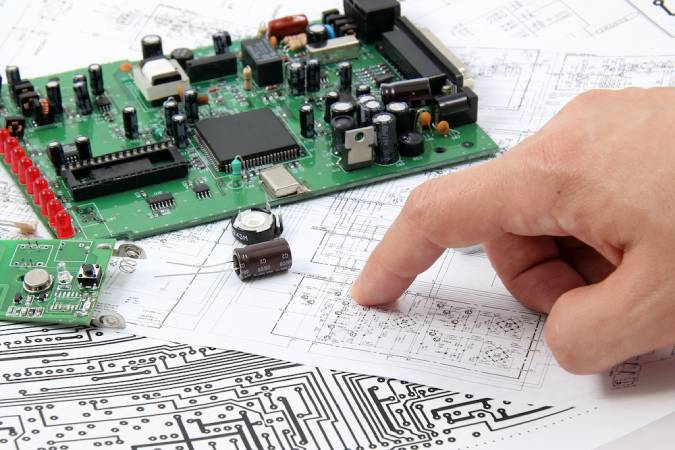
Do you have a passion for technology and engineering? Are you interested in designing and creating electronic systems? If so, then a career in electronic design engineering may be right for you.
This field is growing rapidly, and there are many opportunities available for those who have the skills and knowledge necessary to excel in this industry. In this blog post, we will look at what it takes to become an electronic design engineer in the UK.
What Does an Electronic Design Engineer Do?
As an electronic design engineer, you’ll be responsible for researching, designing, testing, and developing electronic components, systems and products. Your day to day duties may include any or all of the following:
- Developing new designs for electronic products using computer-aided design (CAD) software
- Building prototypes and testing products to assess their performance and identify any issues
- Investigating root causes of failures and finding ways to improve product reliability
- Collaborating with other team members, such as mechanical engineers and software developers, to ensure that all aspects of the product work together seamlessly
- Providing technical support during the manufacturing process to ensure that products are assembled correctly
- Writing technical reports and documentation for customers, managers and other stakeholders
The skills you’ll need to succeed in this role will vary depending on the specific position you’re applying for. However, there are some key abilities that will stand you in good stead no matter what.
These include strong analytical and problem solving skills, excellent attention to detail, great communication skills and the ability to work well under pressure. If you have these and are excited by the prospect of working in this dynamic field, then a career as an electronic design engineer could be a good fit for you.
Becoming an Electronic Design Engineer in the UK

There are four steps to becoming a successful electronic design engineer:
- Doing a relevant degree/course or apprenticeship
- Get work experience
- Apply for jobs
- Keep developing your skills
1. Doing a relevant degree/course or apprenticeship
You will find that many employers require electronic design engineer candidates to have a foundation degree, higher national diploma or degree in a relevant electronics subject. The most common degree for this career path is electrical and electronic engineering.
Some candidates however take the path of pursuing aerospace engineering, physics and applied physics, computer science, maths or other related subjects. As long as electronics is covered as part of the course it could lead to a career in electronic design engineering.
Programmes may include field studies, laboratory studies and classroom studies, as well as electrical circuit theory, differential equations and digital systems designs.
Some electronic design engineering positions may be obtainable with an associate’s degree, which you can typically earn in two years. It could be an option to obtain this degree and continue your education after finding a job.
Another option for becoming an electronic design engineer is to do an apprenticeship. It will usually take three years to complete an apprenticeship as an embedded electronic systems design and development engineer, which will include spending time at a college or similar as well as training on the job.
It is also possible to work towards becoming an electronic design engineer by starting as an electrical or electronics technician and qualifying on the job with relevant training.
2. Get work experience
While you’re studying, it’s a good idea to get some work experience in the industry. If you’re doing an apprenticeship this will be built in, but with a university or college course you’ll have to make your own arrangements. Many employers prefer to hire candidates who have already had some experience working in electronic engineering.
This can be done through internships or part-time jobs during the academic year. These opportunities will give you a chance to learn about the day to day work of an electronic design engineer and see if it’s the right career for you.
You can often receive credits towards your degree for participating in a relevant internship, and course advisors at the university may be able to help you find placements.
Internships are also a good opportunity to start building your professional network. This can be helpful later on when you’re looking for jobs or applying to graduate schools.
3. Apply for jobs
It can be very helpful to consider your network when applying for jobs as an electronics design engineer. Reach out to any professionals you’ve met during internships or relevant part time work to help you to find open positions. These contacts can also be useful as references on job applications.
Job boards and websites are also a great place to find electronic design engineering jobs. There are a number of websites that list electronic engineering positions. You can also search for specific companies that you’re interested in working for, and see if they have any open positions.
To find the right job placement, it can be helpful to seek an entry-level position where you can grow and advance your career within a company.
When you’re applying for jobs, make sure to tailor your resume and cover letter to each specific position. This will show the employer that you’re a good fit for the role, and that you’re interested in working for their company.
It’s also a good idea to include a link to your design portfolio in your application. This will give the employer a chance to see your work, and assess your skills and experience.
4. Keep developing your skills
Even after you’ve landed a job, it’s important to keep developing your skills. The field of electronic engineering is constantly changing and new technologies and methods are being developed all the time.
By keeping up with current trends, and taking courses or attending workshops to learn new skills, you can make sure that you’re always up to date with the latest developments. This will make you more valuable to your employer, and could lead to promotions or other opportunities for career advancement.
It’s also important to stay current on industry trends and developments, as this can help you identify new areas for research and development. This knowledge can be used to create innovative new products or designs, which can give your career a boost.
So there you have it, a four step guide to becoming a successful electronic design engineer. With hard work and dedication, you can achieve your goals and start an exciting new career in this growing field. And who knows, perhaps one day you will join our team at DSL.

